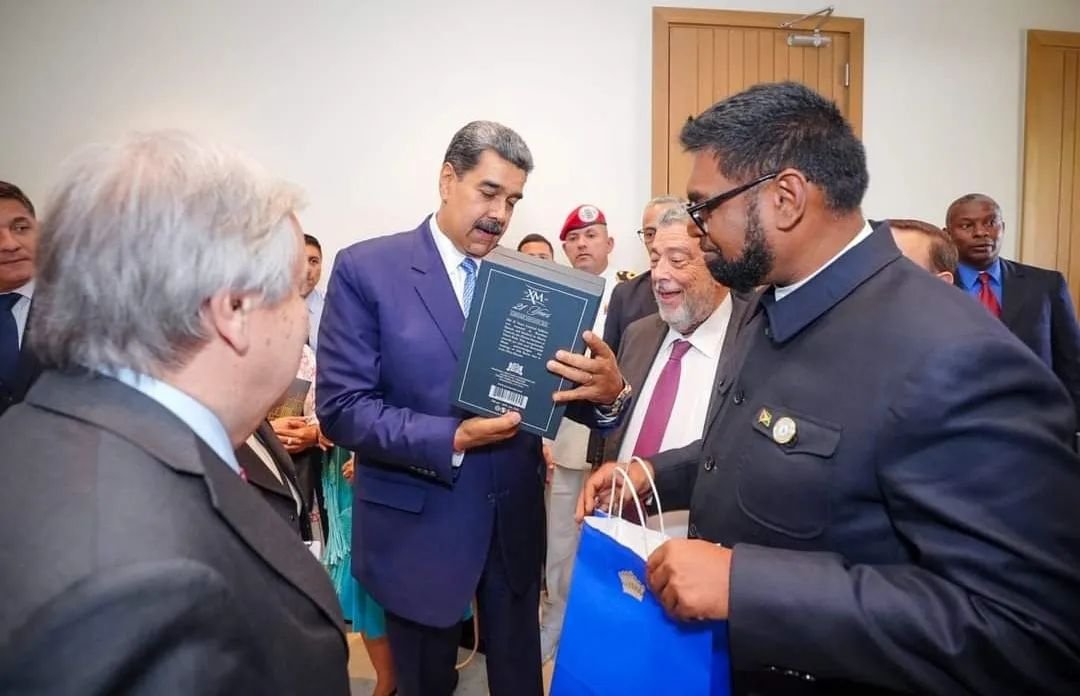Maduro Meets Guyanese President And Makes Election Announcements
UN Secretary-General Antonio Guterres (left), Venezuelan President Nicolas Maduro (middle-left), summit host and St Vincent Prime Minister Ralph Gonsalves (middle-right), and Guyanese President Mohammed Irfaan Ali (right).
On Friday, Venezuelan president Nicolas Maduro landed in Saint Vincent and the Grenadines for the summit of the Community of Latin American and Caribbean States (CELAC).
There, Venezuela’s ruler made significant meetings with regional leaders and announcements regarding the presidential race due this year.
This would be his second visit in two months, as President Maduro landed in Saint Vincent in December to meet with Guyanese president Mohamed Irfaan Ali, where they agreed to de-escalate, with mediation from the CELAC and Brazil.
This time around, a highlight of the event was the second encounter between presidents Maduro and Ali. They exchanged gifts and wished “peace and love” to each other.
The two countries are immersed in a long-standing territorial dispute, dating back to colonial times. It gained prominence late last year, in what many analysts argue was a push to rally support behind the Venezuelan government over a nationalist issue.
Tensions had also been increasing since 2015, when Georgetown allowed an ExxonMobil-led consortium to start exploring and exploiting oil reserves in disputed waters—there is no formal maritime border between the two neighbors. Guyana’s GDP has been booming since, as it could now have the highest ratio of crude barrels per inhabitant.
In early February, the Center for Strategic and International Studies published a report arguing that there was a significant build-up by the Venezuelan military on the border. According to CSIS, this could risk “miscalculation and loss of control over events on the ground.”
However, In a White House press briefing, we heard that the U.S. government believes Venezuelan troop movements “have been of limited nature […] we see no indication that there’s about to be hostilities or that the Venezuelan military would be capable of conducting any significant military activities there.”
Tensions over the Essequibo territory had caused fears regarding Chevron’s acquisition of Hess, which holds a minority stake in the Stabroek offshore oil block, in contested waters. However, while military risk withers away, ExxonMobil, the consortium’s majority shareholder, is trying to stop the takeover of Hess’s 30% share.
Jose Chalhoub, a political risk and oil consultant, says that the visit to the CELAC comes at a key moment in his relationship with the Caribbean Community (CARICOM). “Relations cooled with the Essequibo dispute, as this group sided with Guyana. But they seem to be warming up now, with Brazil’s mediation.”
Chalhoub adds that we must also consider the recent repayment of $500 million from Haiti. “This debt was owed through the Petrocaribe scheme, where Venezuela offered crude and oil products to the region at discounted prices and preferential conditions. Most of us had already given up on these debts, especially given that corruption was rife inside this program. But Maduro could be trying to recover at least a significant part.”
Maduro’s election announcements
Venezuela’s head of state made announcements regarding the presidential election due this year, after a private one-hour meeting with Brazilian president Luis Ignacio “Lula” da Silva. Many analysts already hoped regional leaders on good terms with Maduro could help influence him regarding the vote.
First, President Maduro said that the election will be held in the second half of the year, as is set by the Barbados Agreement. Signed in October between the Venezuelan government and the Unitary Platform—an opposition alliance—the deal included a series of guarantees for the presidential race this year. However, he referenced an agreement in the National Assembly for the electoral route, which does not include the Unitary Platform.
President Maduro also invited the CELAC and the United Nations to send electoral observers, and there will be “audits to guarantee the fairness of the election”. Analysts nevertheless argue that UN observers have a shortfall: they only show the report to the local government and to the Secretary-General, who does not usually share it.
A source in Brussels, who wished to remain anonymous, said that the European Commission will send an observation mission, as long as the Barbados Agreement is respected. The Carter Center was also mentioned in the agreement, although they have not received an invitation to this date.
Presidents Lula and Maduro also discussed illegal mining near the border, “especially in Yanomami indigenous lands,” said a statement by the Brazilian government. The issue gained relevance after the collapse of an illegal mine in Bolivar state on February 20th. According to the mayor of Angostura municipality, Yorgi Arciniega, 25 people died and 15 were injured that day.
Venezuela and Mexico’s foreign affairs ministers also signed a migration agreement before President Maduro, including points on repatriations. Migration from the South American country has increasingly become a contentious problem for Mexico, as more Venezuelans make their way to the U.S. via the land border.

